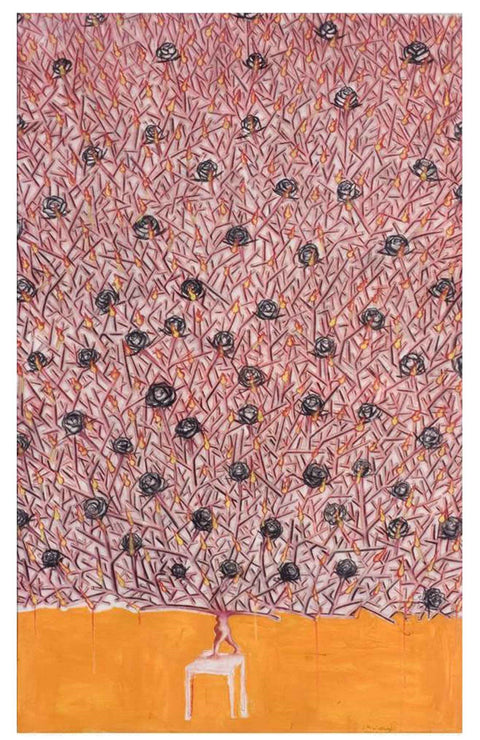Zakir Hussain
Zakkir Hussain was born in 1970 in Chandiroor, Alapuzha, a coastal village in Kerala. Zakkir received a degree in painting from the College of Fine Arts, Trivandrum in 1994 and Masters in Graphics from MS University of Baroda in 1997.
Zakkir inserts a sort of tableau vivante in his works. Representing the struggle between the energies and impulses of human bodies and force of social institutions exerting control over it. His universe is dense with people, discarded objects, ghettoised spaces caught in an array of circumstances. The excess of visual imageries in the surface of many of his works is an outcome of the intensity and simultaneity in which his politico-linguistic strategies confront with multiple notions of realities. These visions are not fantasies, but are critical concerns that the artist recognizes in the interstices of language, in its intervals.
For more than a decade, Zakkir Hussain’s mixed media works have relentlessly tracked the transitional spaces of the everyday. Bright hues, gestural lines and skeins of the pentimento mark the agitated surfaces of his images in a way that seems to evoke moment and dynamic transformation. However, a closer look at the development of his oeuvre reveals that his compositions are consistently underwritten by a litany of stable motifs: the repeated house, the bounded or wounded boy and the empty dress. Each form, though rendered stable through representation, is positioned as a mutable variable in the artist’s visual vocabulary. Whether one considers Hussain’s large sustained works or his smaller studies of individual figures, his continual resurrection and redeployment of key leitmotifs serves as a decisive artistic strategy. Each discrete iteration resonates beyond the image to serve as commentary on a world marked entropy rather than evolution. His disjunctive pairing of organic and inorganic, the actual and illusory tests the limits of the perceptible and the experiential to offer key insight into the often-conflicted forces that animate the contemporary.
Zakkir's works are the declaration against the ordering of the world. They are anti-disciplinary agents which travel through the forgotten and forbidden memories and histories. They are the marker of genealogy of abandoned historical memories, traces of silenced voices; an anthology of the ever- expanding terrain of sufferings. They are in the process of becoming language of unspeakable.
Zakkir Hussain exhibited his works in solos and group shows in India and different part of the world. His noted solo shows are "Procrustean Possibilities", the Guild Art Gallery Mumbai 2018, "Translating The Silence", Vadehra Art Gallery New Delhi, "Prolonged hours of disguised situations", Gallery Ske Bengaluru 2015, "Prints and Drawings" a solo show organised by D. Divakar, Museum of Conflictorium, Ahmedabad, Gujarat - 2016, "Zero Tolerance" Vadehra Art Gallery, New Delhi- 2012, "103 degree Centigrade yellow fever and other works", Gallery Ske Bengaluru 2010, "Re-turn of the unholy", Vadehra Art Gallery New Delhi 2008 among many others.
Zakkir Hussain was invited to participate to the first Kochi Muziris Biennale curated by Bose Krishnamachari and Riyas Komu 2012. His group shows include Cloak and Dagger: India’s fictional times curated by Shaheen Merali at Zuzeum Art Centre Riga Latvia-2021, Lokame Tharavadu (the world is one family) curated by Bose Krishnamachari at Alappuzha, Kerala-2021, Works on Paper - mapping subjects and methods, the Guild Art Gallery, Alibaug, Maharashtra 2020, "Future Present" curated by Satyanad Mohan, Gallery White, Baroda -2018, "Mattancherry" curated by Riyas Komu, Uru Art Harbour Kochi 2017, ”Again and Yet Again”, Gallery OED Mattancherry, Kochi, “Contemporary Contigencies”, curated by Dr. Kathleen Wyma, Gallery OED Mattancherry Kochi-2014 among others.
Zakkir lives and works in Ernakulam in Kerala.
His exhibit with us is a water colour, conte and crayon on paper made in 2005.




